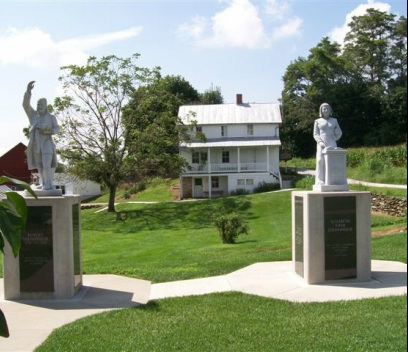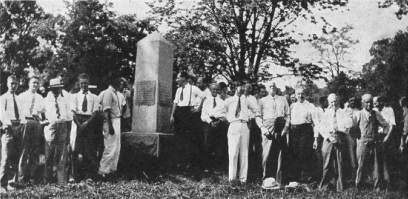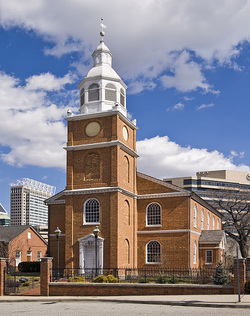Heritage Landmarks

Strawbridge Shrine
A Heritage Landmark of the United Methodist Church, the original portion of the Strawbridge House was built in 1764 as the home of Robert and Elizabeth Strawbridge, emigrants from Ireland where both had heard the preaching of John Wesley and joined his Methodist Society.
Robert began the first Methodist Class in America here, "the First Home of American Methodism". He also began to preach throughout western Maryland and adjoining colonies, and more controversially, to administer the sacraments. Elizabeth is credited with making the first Methodist Conversion in America, that of John Evans, whose house is also preserved on the site by the Strawbridge Shrine Association.
For more on the significance of this landmark see the General Commission
on Archives & History Traveler's Guidebook 'landmark page'.
For further information on the site, see the Shrine Association 'website'.

Geeting Meetinghouse site
The principal site of the United Brethren Founding Sites Heritage Cluster, the site of the Geeting Meetinghouse was the meeting place of a class under George Adam Geeting, a schoolmaster commissioned by Philip Wm. Otterbein and ordained in his German Reformed Church in 1783. The original Meetinghouse was succeeded by Mt. Hebron Chapel in 1845 and in 1880 by the Salem Church in Keedysville, which has maintained the site since that time.
For more on the significance of this landmark see the General Commission on Archives & History Traveler's Guidebook, 'cluster page'.
The principal site of the United Brethren Founding Sites Heritage Cluster, the site of the Geeting Meetinghouse was the meeting place of a class under George Adam Geeting, a schoolmaster commissioned by Philip Wm. Otterbein and ordained in his German Reformed Church in 1783. The original Meetinghouse was succeeded by Mt. Hebron Chapel in 1845 and in 1880 by the Salem Church in Keedysville, which has maintained the site since that time.
For more on the significance of this landmark see the General Commission on Archives & History Traveler's Guidebook, 'cluster page'.

Old Otterbein
A Heritage Landmark of the United Methodist Church, Old Otterbein Church is the Mother Church of the United Brethren in Christ, one of two "German Methodist" denominations which merged to form the Evangelical United Brethren Church in 1946 and then with The Methodist Church to form The United Methodist Church in 1968. Built in the pastorate of Philip Wm. Otterbein in 1785, Old Otterbein is the oldest church in continuous use in the City of Baltimore.
It is built on the site of a German Meetinghouse in which met the first Baltimore Methodist Meeting 22 June 1772.
For more on the significance of this landmark see the General Commission
on Archives & History Traveler's Guidebook 'landmark page'.
For more on the history of the church, see its 'history page'.
|
Lovely Lane Meetinghouse site
The first Methodist Meeting in Baltimore City, which first met on the site where Old Otterbein Church would be built, built a meetinghouse on Lovely Lane in 1774. Here, at the end of 1784, the Methodist Episcopal Church was formed in the Christmas Conference. The congregation left the site for a church on Light Street, and later moved uptown on Charles Street, before laying the cornerstone for the present Lovely Lane Church in 1884. The Lovely Lane site is now marked as a Heritage Landmark. For more on its significance, see the General Commission on Archives & History Traveler's Guidebook 'landmark page'. For more on the church's history see its 'history page'. |
Cokesbury College site
The first Methodist College in America was opened at Abingdon in Harford County in 1787. At the Christmas Conference it was decided to name the College "Cokesbury", combining the names of bishops Coke and Asbury. The college was troubled from its founding and burned to the ground in 1795. It was then relocated to a site adjacent to the Light Street Church. However, this too burned the next year (taking the first Light Street Church down as well) and it was decided to end the project. The site is maintained by Cokesbury Memorial Church. For more on its significance, see the General Commission on Archives & History Traveler's Guidebook 'landmark page'. |
